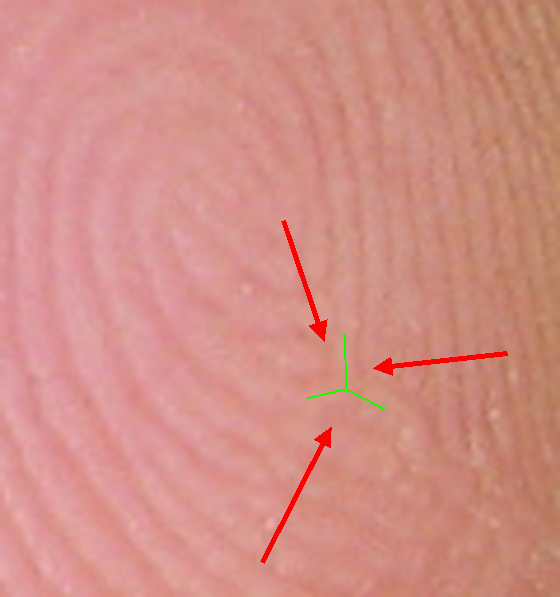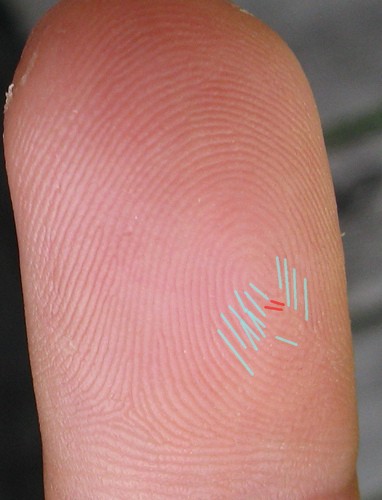None
Most users ever online was 387 on Tue Dec 05, 2023 7:35 pm
The newest registered user is Skylines3
Our users have posted a total of 47502 messages in 4941 subjects
| No user |
• The FREE hand reading services at the Modern Hand Reading Forum are being continued in 2019 with the assistance of Google adsense!

Learn how to read hands according the Modern Hand Reading paradigm & you can use this forum as your palm reading guide!
deleted deleted
Modern Hand Reading Forum - Discover the language of your hands: palm reading & palmistry forum! :: III - MODERN HAND READING - Various systems for reading hands! :: IIIa - Modern Palmistry: general topics, questions :: IIIg - Dermatoglyphics + fingerprints
Page 1 of 3 • 1, 2, 3 
kiwihands- Posts : 364
Join date : 2011-01-09
Location : nowhere
 Re: deleted deleted
Re: deleted deleted
Hello Kiwihands,
I think your first thought was just fine: because I think we can simply call it a 'peacock' (or in the F.B.I. vocabulary: a 'central pocket loop').
Though I admit, at first sight I thought that there could be a double loop inside the 'whorling pattern', but I don't think that one can speak of 'independent shoulders'.
Regarding the 'inner triradius', I don't see any trouble regarding my definition of a 'triradius' (because the ridges around the triradius can be described as a 'confluence of three parallel ridge fields').
By the way... which aspect of my definition did you have in mind (that might not suite a specific aspect of my definition)?


Patti- Posts : 3912
Join date : 2010-07-24
 Re: deleted deleted
Re: deleted deleted
Last edited by kiwihands on Mon Apr 16, 2018 10:05 pm; edited 1 time in total
kiwihands- Posts : 364
Join date : 2011-01-09
Location : nowhere
 Re: deleted deleted
Re: deleted deleted
Last edited by kiwihands on Mon Apr 16, 2018 10:07 pm; edited 1 time in total
kiwihands- Posts : 364
Join date : 2011-01-09
Location : nowhere
 Re: deleted deleted
Re: deleted deleted
http://www.policensw.com/info/fingerprints/finger07.html#central
Last edited by Patti on Tue Apr 19, 2011 6:23 pm; edited 1 time in total

Patti- Posts : 3912
Join date : 2010-07-24
 Re: deleted deleted
Re: deleted deleted
Last edited by kiwihands on Mon Apr 16, 2018 10:10 pm; edited 1 time in total
kiwihands- Posts : 364
Join date : 2011-01-09
Location : nowhere
 Re: deleted deleted
Re: deleted deleted
Last edited by Patti on Tue Apr 19, 2011 6:22 pm; edited 1 time in total

Patti- Posts : 3912
Join date : 2010-07-24

Patti- Posts : 3912
Join date : 2010-07-24
 Re: deleted deleted
Re: deleted deleted
Hi Kiwihands,
Thanks for explaining your thoughts/doubts.
In the picture below I have highlightened all elements.
Re: http://dhi.health.state.nm.us/elibrary/cchspmanual/fingerprint_manual.pdf (see the page that is numbered 28) - Patti's source is very helpful to understand that this pattern could be described as an 'S-pattern' but not as a 'double loop' - because for a 'double loop' the '2 shoulders' of the two cores are required not to be connected (but they are connected in your example).
And figure 232 in the F.B.I. book shows similar characteristics, so ... since the S-pattern can manifest in the F.B.I. system as either a 'whorl' or a 'central pocket loop', ... I think it is obvious that it has to be a 'central pocket loop' since there are no 'whorling ridges' that cross the imaginary light blue line between the two deltas.
Finally, I hope that my 3 red arrows are sufficient for you to recognize that in thie 'central pocket loop' there is also a meeting of 3 'parallel ridge fields' at the inner delta.
PS. I think the argument of an 'obstruction' only applies to very small patterns (for example when there are no 'whorling ridges', no S-pattern ridges', and no 'double looping ridges').
I hope this all makes sense now!?



Patti- Posts : 3912
Join date : 2010-07-24

Patti- Posts : 3912
Join date : 2010-07-24
 Re: deleted deleted
Re: deleted deleted
Patti wrote:
This is how I trace the ridges. I cannot find an enclosure or pocket.
Patti, if you think it is not a 'central pocket loop'... then what is you alternative when using the F.B.I.'s pattern classification?
(So far you you haven't shared an alternative classification, so I am not sure in what direction your 'arguments' are going as an alternative...?)

Patti- Posts : 3912
Join date : 2010-07-24
 Re: deleted deleted
Re: deleted deleted
I knew I should have taken a pencil print - now it's too late. This particular friend is captain on a traditional voyaging vaka and has yesterday set out for an epic journey around the entire pacific - so I won't see him again for a very long time. I just quickly traced the ridges on photoshop while I had his live hand here when he said goodbye, so unfortunately this is the best I've got. I'm pretty sure my tracing is correct though - particularly those three (red) short ridges in the centre, I was surprised to see that they weren't connected to any other ridges. It would have made a lot more sense otherwise! Also, the right arm of the triradius is not actually connected (although it looks like it on the photo), but abuts onto the ridge coming from the proximal area that forms the other two arms of the triradius.
I completely agree with you when you say "I think this pattern is somewhere between a double loop and a loop pattern. There is no contained (pocket) whorl or pattern. The pattern enters and leaves from the same side of the finger." It does look like a central pocket whorl, but without a ridge making a complete circuit or an obstruction at right angles - it can't be?
Unfortunately I can't look at the link to the pdf you've sent - have gone over our data allowance and now on dial-up speed til Thursday - it's still trying to load after half an hour's wait. I'll leave it on for the day, but ...

kiwihands- Posts : 364
Join date : 2011-01-09
Location : nowhere
 Re: deleted deleted
Re: deleted deleted
Last edited by kiwihands on Mon Apr 16, 2018 10:27 pm; edited 1 time in total
kiwihands- Posts : 364
Join date : 2011-01-09
Location : nowhere
 Re: deleted deleted
Re: deleted deleted
kiwihands wrote:Hi Martijn,
Thanks for your detailed explanations!Good to know that on a fingerprint only the ridges closest to the triradius count. Also, looking at your top arrow (being inserted at a 45 degree angle to the ridges), I see I must have misinterpreted the your definition with regards to the requirement that the arrows have to be at right angles to the flow.
The example you mention as a similar pattern in the FBI book I can't really follow though - 232 has at least two ridges making a complete circuit inside the pattern area, whereas my example here has none? Also in 232 there are no short abutting ridges inside the pattern area? Sorry, there may be something I'm just not seeing here ...

Thanks for your help Martijn, much appreciated!
Kiwihands, regarding the degree between the red angle, the ridges and the 'light blue lines'... if you follow the path of the ridges - and if you ignore my 'light blue lines' - than you will notice that my 'red angle' is positioned almost at 90 degrees to the path of the ridges.
Thanks for pointing out this aspect in my earlier drawing, I apologize for the confusion created by my 'light blue lines': you can consider that as an 'imperfection' in my drawing.
Your thought about the 90 degrees proofs that you very well understood correctly what I described in my definition!

PS. Especially, if you ignore the first 'ridge snippet' about the inner triradius... then you will see that the direction of my 'red angle' is positioned at about 90 degrees of the ridges involved.

 Re: deleted deleted
Re: deleted deleted
Kiwihands, after ignoring the 'ridge snippet': voila!
(In my earlier picture I should have better drawn the upper angles as seen in the picture below)
I hope this correction will make it more easy for you to recognize what I wanted to point out with the upper red arrow. Does this now makes sense of you (again)?


Patti- Posts : 3912
Join date : 2010-07-24
 Re: deleted deleted
Re: deleted deleted

Posting Kiwi's image here so it's easier to see.

Patti- Posts : 3912
Join date : 2010-07-24

Patti- Posts : 3912
Join date : 2010-07-24
 Re: deleted deleted
Re: deleted deleted
Patti wrote:Martijn (admin) wrote:Patti wrote:
This is how I trace the ridges. I cannot find an enclosure or pocket.
Patti, if you think it is not a 'central pocket loop'... then what is you alternative when using the F.B.I.'s pattern classification?
(So far you you haven't shared an alternative classification, so I am not sure in what direction your 'arguments' are going as an alternative...?)
I'm hoping we can all work out together what we should call it - based on FBI rules.
That's why I uploaded Disney's print. It has an obvious large 'double loop' (to me) and the FBI labeled it a loop. One of my little finger's has this same type of print which I always thought was a variety of a whorl - I didn't see the complete print until I used the pencil and tape method.
I think this pattern is somewhere between a double loop and a loop pattern. There is no contained (pocket) whorl or pattern. The pattern enters and leaves from the same side of the finger. The second triradius should give it a whorl category.
The FBI guidelines state:The fact that there must be two separate loop formations eliminates from consideration as a double loop the "S" type core, the interlocking type core, and the formation with one loop inside another." - FBI book page 55
The images last night looked like an "S" type, when I outlined it today, I found it to be what I think they are calling "interlocking".
Although I think it's much 'fancier' than a plain loop, I think the FBI's rules will mark it a loop. I have no final opinion, yet.
Maybe Kiwi could get her pencil and tape out again?
Hi Patti, thanks for answering my question.
But first of all: yes, I do agree with you that in the 1933 print of Disney's right pinky finger we see a clear 'double loop'.
However... additionally, I would like to point out here that in the two 1937 prints of the right little finger we can hardly see the double loop - because the quality of those fingerprints is quite disturbed at the ulnar side.
So...
The 'ridge count 16' could be a mistake due to the poor quality of the print in the right zones; however... there is another posibility!!
Because there are actually multiple methods for making ridge counts! - And some methods only require the use of the ridge count of the outward positioned 'delta'.
(And maybe you should also be aware that this Disney prints probably was not made by an F.B.I. official - because Disney's fingerprints only served as a requirement for getting a driver's licence)
MY CONCLUSION: We better not continue this discussion about Kiwihands' new fingerprint with these 'arbitrary' observations from Disney's pinky finger.
(And Patti, if you do prefer to continue considering these 'arbitrary observations'.... sorry, then it might soon no longer make sense for me to continue to provide you further feedback about your thoughts, etc. Because I have shared my reasons for questioning some of your 'assumptions' regarding the Disney pinky finger example)
However Patti, I do have an interesting alternative print for consideration....
Because as an alternative for the Disney example, I would like to invite you to take a closer look at figure 232 in the F.B.I. book (which I already mentioned earlier in this discussion).
I am looking forward to hear if you recognize the similarities with Kiwihands' example.
NOTICE:
In figure 232 we don't see any 'complete whorling ridge' either (just like in Kiwihands' example), but there is a likewise S-shaped pattern (not a 'double loop' either, because the shoulders involved are connected)... and it is classified as a 'central loop pocket'!
Again ... I am looking forward to hear your thought about that example!
(Actually, I hope that you will recognize what I just described about figure 232... because that should make you able to 'jump of the fence'... and formulate a permanent opinion about Kiwihands example as well)
 Re: deleted deleted
Re: deleted deleted
Patti wrote:Patti wrote:
...Patti wrote:
Posting Kiwi's image here so it's easier to see.
Kiwi, your image also shows an interlocking pattern, too.
I think the double loop is spoiled by this.
Patti... I don't see any 'interlocking pattern' at all (like the ones described in the F.B.I. book at page 16, figure 46-48).
All I see is an 'S-pattern' with connected shoulders, and I can see it in the original photocopy + the reversed image.
NOTICE: I used a very thin purple line to outline how the 'S-shape'... without taking away the visibility of the 'ridge + groove flow'.
(By the way, Patti you are making the same mistake as Kiwihands did: you are trying to study the 'ridge flow' in a far too large zone of this fingerprint... and regarding your example with the light blue lines - it is a bit of a mystery to me why you did not simply focuss on the ridges just outside the area of the inner delta.... instead you ONLY considered ridges that are quite far away from the inner 'delta'. So your choice do not makes sense in the perspective of that the goal of such an analysis should really ALWAYS befocussed on the ridge surrounding the 'delta'.)

NOTICE: Please ignore the 'dark red arrows' in the picture below.... those are the result of Kiwihands' first attempt to draw arrows that reflect the 'confluencing' aspect of the ridges surrounding the 'delta'. Only the green and purple lines make my point.

[strike]
Last edited by Martijn (admin) on Mon Apr 18, 2011 11:36 pm; edited 1 time in total

Patti- Posts : 3912
Join date : 2010-07-24
 Re: deleted deleted
Re: deleted deleted
Martijn (admin) wrote:Patti wrote:Patti wrote:
...Patti wrote:
Posting Kiwi's image here so it's easier to see.
Kiwi, your image also shows an interlocking pattern, too.
I think the double loop is spoiled by this.
Patti... I don't see any 'interlocking pattern' at all (like the ones described in the F.B.I. book at page 16, figure 46-48).
All I see is an 'S-pattern' with connected shoulders, and I can see it in the original photocopy + the reversed image.
NOTICE: I used a very thin purple line to outline how the 'S-shape'... without taking away the visibility of the 'ridge + groove flow'.
(By the way, Patti you are making the same mistake as Kiwihands did: you are trying to study the 'ridge flow' in a far too large zone of this fingerprint... and regarding your example with the light blue lines - it is a bit of a mystery to me why you did not simply focuss on the ridges just outside the area of the inner delta.... instead you ONLY considered ridges that are quite far away from the inner 'delta'. So your choice do not makes sense in the perspective of that the goal of such an analysis should really ALWAYS befocussed on the ridge surrounding the 'delta'.)
NOTICE: Please ignore the 'dark red arrows' in the picture below.... those are the result of Kiwihands' first attempt to draw arrows that reflect the 'confluencing' aspect of the ridges surrounding the 'delta'. Only the green and purple lines make my point.
[strike]
ummm?
But I see how you have drawn it so it's an "S".

Patti- Posts : 3912
Join date : 2010-07-24
Page 1 of 3 • 1, 2, 3 
 Similar topics
Similar topics» deleted deleted
» Payalrihansh hand reading request
» deleted deleted
» deleted deleted
Modern Hand Reading Forum - Discover the language of your hands: palm reading & palmistry forum! :: III - MODERN HAND READING - Various systems for reading hands! :: IIIa - Modern Palmistry: general topics, questions :: IIIg - Dermatoglyphics + fingerprints








» Teacher square on my Jupiter mount
» Handreading International Conference 2024
» Can anyone read it for me?
» Are there any signs in the hands that you are a twin flame?
» Square on Marriage line
» Cross in mount Jupiter
» clinodactyly: top phalanges bending towards Mercury finger
» Can anybody please read this hand
» Nisha Ghai
» Absolutely non-sense career till now
» Fate Destiny Line -
» VIII - Palmistry books TOP 100 - listed by 'Amazon Sales Rank'!
» Stewart Culin - Palmistry in China and Japan
» Herbert Giles - Palmistry in China